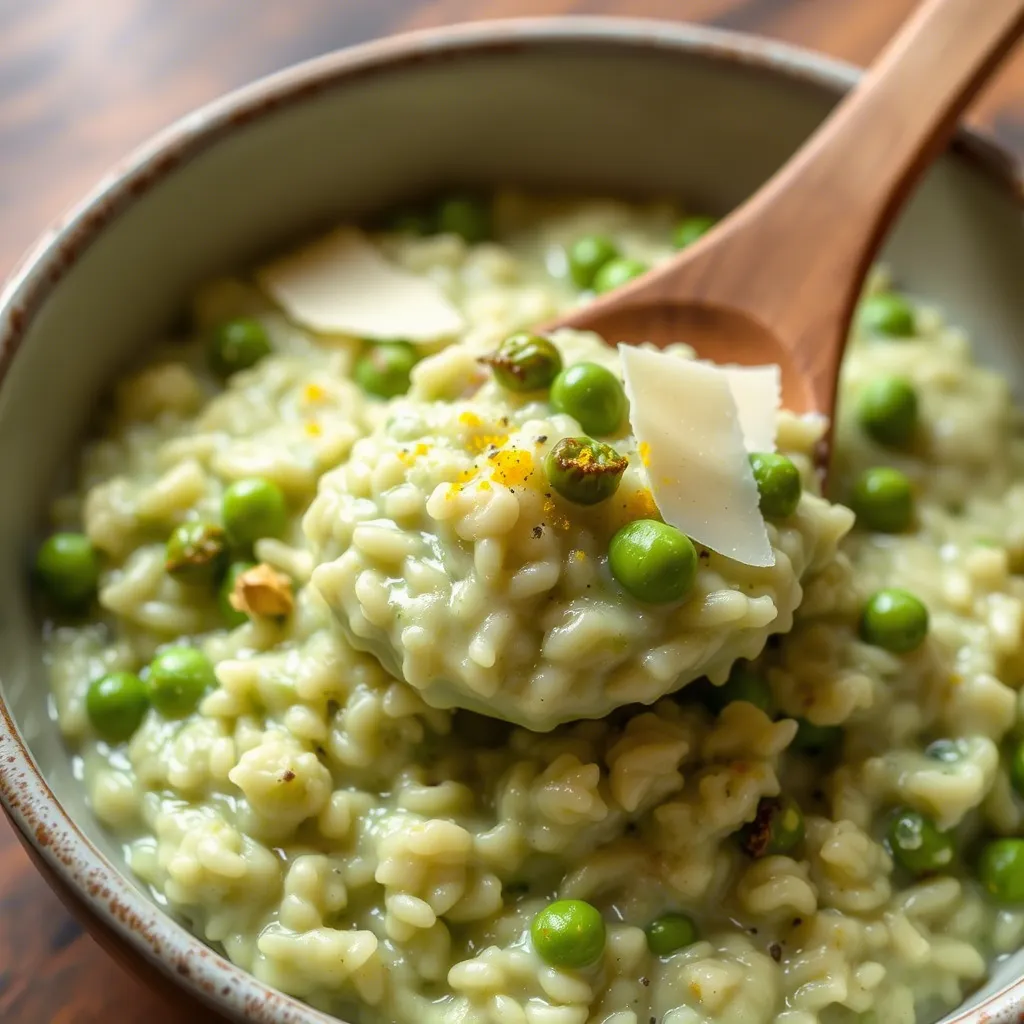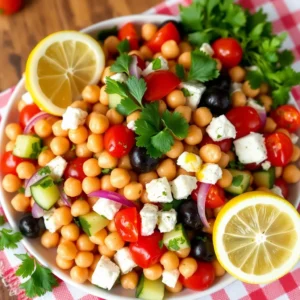Why You’ll Love This Spring Pea and Asparagus Risotto
There’s something magical about the first verdant bursts of spring that makes me want to rush straight to the kitchen. This Spring Pea and Asparagus Risotto captures everything wonderful about the season in one gloriously creamy bowl. As a busy parent myself, I understand the constant juggling act between wanting to serve something special and actually having the time to make it happen. That’s exactly why this spring risotto has become a staple in my household when those first farmer’s market peas and asparagus spears appear.
Let me tell you, this isn’t your intimidating restaurant-only risotto that demands constant attention like a newborn baby. This is your “I’ve got fifteen other things to do but still want to feel like a kitchen champion” risotto. The creamy rice provides the perfect canvas for those bright, tender spring peas and crisp asparagus spears that pop with freshness in every bite.
For busy moms trying to squeeze in a homemade dinner between soccer practice and homework help, this dish offers an appealing compromise. Yes, you’ll need to stir occasionally, but it’s not the constant babysitting that risotto’s reputation might suggest. Think of it as therapeutic stirring with breaks built in – just enough time to help with a quick homework question or send that work email you forgot about.
What makes this spring risotto truly special is how it bridges the gap between comfort food and fresh, seasonal eating. The rice becomes deliciously creamy without requiring heavy cream, while the spring vegetables add nutrition and vibrant color that makes the plate look like you spent hours on presentation. It’s hearty enough to satisfy without weighing you down – precisely what we crave as winter finally releases its grip.
If you’ve got picky eaters at home (and who doesn’t?), this pea and asparagus risotto often works miracles. Something about the creamy rice texture makes vegetables more approachable, and you can always adjust the veggie-to-rice ratio for those still warming up to green things. I’ve seen children who “hate peas” suddenly become pea enthusiasts when they’re nestled in this velvety rice mixture.
And the versatility! Serve it as a stunning main dish with a simple salad, or as a sophisticated side alongside a protein. It reheats beautifully for lunch the next day (if there’s any left), making it the gift that keeps on giving during hectic weekdays. You might even find yourself making a double batch just to ensure those coveted leftovers.
The Story Behind This Spring Pea and Asparagus Risotto
My journey with this Spring Pea and Asparagus Risotto began nearly a decade ago during a particularly rainy April when cabin fever had reached its peak in our household. The farmers market had just started displaying those first precious spring vegetables, and despite the drizzle, I’d loaded up on bright green peas and slender asparagus spears with absolutely no plan for how to use them.
“Mom, when is winter going to end?” my youngest had asked that afternoon, staring forlornly out the window at yet another gray sky. The question wasn’t really about the weather, I knew – it was about that universal feeling of emerging from the cocoon of winter, of craving brightness and renewal.
That evening, with rain pattering against the windows, I decided we needed to bring spring indoors. I’d been intimidated by risotto for years – all those celebrity chef warnings about constant stirring and precise timing had me convinced it was beyond my casual home cook abilities. But sometimes, a rainy day gives you courage. “What’s the worst that could happen?” I thought. “Mushy rice for dinner and we order pizza instead?”
I put on some upbeat music, poured a small glass of the white wine I’d be using in the recipe (cook’s privilege!), and called the kids into the kitchen. “We’re bringing spring to dinner tonight,” I announced with more confidence than I felt. My oldest raised an eyebrow but was quickly assigned arborio rice-measuring duty. My youngest became the official pea shucker, a job that resulted in almost as many peas being eaten raw as made it into the bowl.
The stirring became a family affair, each of us taking turns adding ladles of warm broth and stirring the gradually softening rice. We talked, laughed, and suddenly the rain outside seemed cozy rather than gloomy. When we finally stirred in those vibrant green vegetables, their color seemed to brighten the entire kitchen.
That first batch wasn’t perfect – I’d been a bit generous with the garlic and slightly timid with the salt – but the moment we sat down to those steaming bowls of spring risotto, something special happened. The conversation flowed, second helpings were requested (even by my vegetable-suspicious middle child), and for dessert, we simply had more risotto.
Since that rainy spring evening, this dish has been requested for birthdays, brought to new parents in the neighborhood, and served at Easter gatherings. It’s evolved over time as I’ve learned to make homemade vegetable stock (which takes this risotto to another level entirely), but the heart of it remains the same: spring’s promise in a bowl.
The most telling endorsement came last year when my now-teenage daughter called from college: “Mom, I’m making risotto for my roommates tonight – talk me through it?” As I recited the steps from memory, I could almost see her stirring the pot in her tiny dorm kitchen, bringing a piece of home and the taste of spring to her new friends. Some recipes feed more than just hunger – they feed connection, and this Spring Pea and Asparagus Risotto has become our family’s edible heirloom.
Ingredients
The beauty of Spring Pea and Asparagus Risotto lies not just in its creamy texture and vibrant appearance, but in how relatively simple the ingredient list is. Each component plays an essential role in building layers of flavor, so let’s break down exactly what you’ll need to create this springtime masterpiece:
Arborio Rice (1½ cups): This is non-negotiable, friends. The high starch content in arborio rice creates that signature creamy texture without adding actual cream. Could you use carnaroli or vialone nano rice? Absolutely – these Italian rice varieties are also excellent for risotto. But please don’t try substituting regular long-grain rice or (heaven forbid) instant rice. The dish simply won’t achieve that luxurious consistency we’re aiming for.
Fresh Spring Peas (1 cup, shelled): There’s something meditative about shelling fresh peas, and their sweet pop is worth every minute of preparation. However, I live in the real world where time isn’t always abundant, so frozen peas make an excellent substitute. They’re flash-frozen at peak freshness and will save you considerable prep time. If using frozen, don’t thaw them – just add them straight from the freezer during the last few minutes of cooking.
Fresh Asparagus (1 bunch, about 1 pound): Look for slender stalks with tight, compact tips. Thicker asparagus can be woody, requiring peeling before use. To prep, snap off the tough ends (they’ll break naturally at the right spot), then cut into 1-inch pieces, reserving the prettiest tips for garnish.
Vegetable Broth (6 cups): The liquid that transforms hard rice into creamy perfection deserves attention. Homemade vegetable stock is ideal, but a good-quality store-bought version works well too. Keep it simmering in a separate pot while you cook – adding cold broth to risotto will interrupt the cooking process and result in uneven texture.
White Wine (½ cup): Choose something dry that you’d actually drink – a Pinot Grigio or Sauvignon Blanc works beautifully. The alcohol cooks off, leaving behind brightness that balances the richness. If you prefer to cook without alcohol, substitute with additional vegetable broth and a squeeze of lemon juice to add acidity.
Shallots (2 medium, finely diced): Shallots provide a more delicate onion flavor that doesn’t overpower the vegetables. If you don’t have shallots, half of a small yellow onion will work in a pinch.
Garlic (2 cloves, minced): Just enough to add depth without taking center stage. More is not necessarily better here – we want to complement, not compete with, our spring vegetables.
Butter (3 tablespoons, divided): We’ll use some at the beginning to sauté our aromatics, and save some for the end. That final pat of butter is what Italians call “mantecare” – the process that gives risotto its ultimate silky finish.
Olive Oil (2 tablespoons): Use a good-quality extra virgin olive oil – it makes a difference in the final flavor.
Parmesan Cheese (½ cup, freshly grated, plus more for serving): Please, please grate it yourself rather than using pre-grated varieties with anti-caking agents. The meltability and flavor are worlds apart.
Lemon Zest (from 1 lemon): The secret ingredient that makes this spring risotto sing. That bright note cuts through the richness and amplifies the fresh vegetable flavors.
Fresh Herbs (2 tablespoons chopped, such as mint, basil, or chives): Choose based on what looks best at the market. Mint pairs beautifully with peas, while chives add a subtle onion note that enhances without overwhelming.
Salt and Freshly Ground Black Pepper: Season gradually throughout cooking rather than all at once, tasting as you go.
Optional but recommended:
- A splash of heavy cream (2-3 tablespoons) for extra decadence
- Toasted pine nuts for garnish
- Pea shoots or microgreens for a restaurant-worthy presentation
Execution
Creating the perfect Spring Pea and Asparagus Risotto is less about technical skill and more about understanding the rhythm of the process. Think of it as a dance with simple steps that, when performed mindfully, creates something magical. Let’s break it down into manageable stages:
Preparation Phase (10 minutes):
- Before you do anything else, bring your vegetable broth to a simmer in a medium saucepan, then reduce the heat to low to keep it warm throughout the cooking process.
- Prep your vegetables: shell the peas if using fresh; trim the asparagus by snapping off the woody ends, then cut into 1-inch pieces, keeping the tips separate from the stems.
- Place a large, heavy-bottomed pan (I prefer a wide, shallow Dutch oven) over medium heat. This is your risotto vessel – choose wisely as you’ll be stirring in this pot for the next 30 minutes.
Flavor Foundation (5 minutes):
- Add 1 tablespoon of butter and the olive oil to your pan. Once the butter melts and starts to foam slightly, add the diced shallots. Cook for 2-3 minutes until they’re translucent but not brown – we want soft, sweet aromatic flavors, not caramelization.
- Add the minced garlic and cook for just 30 seconds until fragrant. If it starts to turn golden, your heat is too high – garlic can go from perfect to bitter in seconds!
- Add the arborio rice and stir to coat each grain with the buttery mixture. This step is crucial – you’re creating a protective fat coating around each grain that will help it release its starch gradually. Cook for 1-2 minutes until the edges of the rice grains become translucent while the centers remain white.
The Wine Moment (1 minute):
- Pour in the white wine and listen for that satisfying sizzle. Stir constantly until the wine is almost completely absorbed. This deglazing step adds acidity and depth that’s unmistakable in the finished dish.
The Meditation Phase (18-22 minutes):
- Now begins the core risotto technique. Add one ladle (about ½ cup) of the warm broth to the rice. Stir gently but consistently until the liquid is mostly absorbed. The rice shouldn’t be dry, but there shouldn’t be visible broth floating on top either.
- Continue this process of adding broth one ladle at a time, stirring until absorbed before adding the next. This is where risotto gets its reputation for being labor-intensive, but I find it meditative rather than taxing. It’s the perfect time to sip that glass of white wine you opened for the recipe or catch up on the day with family members.
- After about 15 minutes of adding broth and stirring, start tasting the rice. You’re looking for al dente texture – tender with slight resistance in the center, similar to perfectly cooked pasta.
Vegetable Integration (5 minutes):
- When the rice is nearly done (typically around the 18-minute mark), add the asparagus stems (not the tips yet). Stir and cook for 2 minutes.
- Add the asparagus tips and fresh or frozen peas. Stir gently to incorporate, adding another ladle of broth if needed. The vegetables should cook for just 2-3 minutes – we want them vibrant and slightly crisp, not mushy.
The Finishing Touches (3 minutes):
- Once the rice is perfectly al dente and the vegetables are tender-crisp, remove the pan from heat. This is critical – residual heat will continue cooking everything, so stopping slightly early prevents overcooking.
- Add the remaining 2 tablespoons of butter, grated Parmesan, and lemon zest. Stir vigorously – this final stirring creates that signature creamy texture. If using, add a splash of heavy cream now.
- Cover and let rest for 2 minutes – this resting period allows the flavors to meld and the texture to reach perfect creaminess.
- Uncover, give it one final stir, and taste for seasoning. Add salt and freshly ground black pepper as needed.
The perfect spring risotto should slowly spread on the plate when served, not stand in a firm mound. Garnish with fresh herbs, additional Parmesan, and if desired, a few edible flowers for that Instagram-worthy presentation. According to Serious Eats’ risotto science, that coveted creamy texture comes not just from the rice’s starch, but from the emulsion of that starch with fat and liquid – so don’t skip those final butter and cheese additions!
Remember, if your first attempt isn’t perfect, that’s part of the journey. My first risotto was slightly too al dente, but practice makes progress. Before long, you’ll be making this spring risotto with the confidence of an Italian nonna, adjusting broth and timing by feel rather than strict measurement.
Additional Tips
Mastering Spring Pea and Asparagus Risotto is like learning to ride a bike – once you’ve got it, you’ll never forget. But even experienced riders appreciate a few insider tips, so let’s dive into some practical advice that will elevate your spring risotto from good to unforgettable.
Perfect Timing: One of the biggest challenges with risotto is coordinating the doneness of the rice with the vegetables. For optimal texture, remember that asparagus stems need about 4-5 minutes of cooking time, while tips need just 2-3 minutes. Fresh peas require 3-4 minutes, while frozen peas need only 1-2 minutes. If you’re unsure, it’s better to add vegetables slightly later than too early – overcooked spring vegetables lose their vibrant color and delicate flavor.
The Broth Factor: The quality of your broth dramatically impacts the final dish. If using store-bought, choose low-sodium varieties so you can control the saltiness. For an amazing flavor boost, try simmering your broth with asparagus stems and pea pods for 20 minutes before straining and using. This infuses the liquid with the essence of the vegetables themselves, creating a beautiful harmony in the finished dish.
Risotto for Meal Prep: Yes, you can make risotto ahead of time! Cook it until it’s about 80% done (slightly underdone), spread on a baking sheet to cool quickly, then refrigerate. When ready to serve, transfer to a pan, add hot broth, and finish cooking. This method is a lifesaver for entertaining or busy weeknights.
Storage Solutions: Leftover risotto will thicken considerably in the refrigerator as the rice continues to absorb moisture. Store in an airtight container for up to 3 days. When reheating, add a splash of hot broth or water and stir frequently to restore that creamy consistency. A fresh grating of Parmesan and sprinkle of herbs will make it taste freshly made.
Texture Troubleshooting: If your risotto turns out too thick, simply add more hot broth until you reach the desired consistency. If it’s too thin, continue cooking for a few more minutes, stirring vigorously to help the rice release more starch. Remember that risotto will naturally thicken as it sits, so serve immediately after that final rest for the perfect texture.
Veggie Variations: While peas and asparagus are the quintessential spring combination, don’t be afraid to experiment based on what looks freshest at the market. Fava beans make a delicious substitute for peas, while tender spring onions or ramps can replace or complement the shallots. For a more substantial meal, consider folding in some sautéed wild mushrooms or topping with a perfectly poached egg.
Cheese Please: Parmesan is traditional, but don’t let tradition limit you. Aged pecorino adds a sharper, saltier note, while a dollop of creamy mascarpone creates an exceptionally luxurious finish. For a less traditional but delicious twist, try crumbling some goat cheese on top just before serving – the tangy creaminess pairs beautifully with spring vegetables.
Wine Pairing: This risotto pairs beautifully with the same style of wine you used in cooking – a crisp Pinot Grigio or Sauvignon Blanc. The bright acidity cuts through the creamy richness while complementing the vegetable flavors. For something unexpected, try a sparkling Prosecco – the bubbles provide a refreshing contrast to the creamy rice.
Transforming Leftovers: If you have leftover risotto, transform it into arancini (Italian rice balls). Simply form the cold risotto into balls, insert a small cube of mozzarella in the center, roll in breadcrumbs, and either deep fry or air fry until golden. These make an incredible appetizer or lunch the next day.
Special Diets: This recipe is easily adaptable for different dietary needs. For a vegan version, substitute the butter with additional olive oil and either omit the cheese or use a plant-based alternative. For a lighter version, skip the final butter addition and reduce the cheese by half – you’ll still get a creamy result with fewer calories.
Presentation Perfection: For a restaurant-worthy presentation, serve your risotto in warm, shallow bowls. Rather than mounding it in the center, spread it across the bowl in an even layer and create a slight well in the center. Arrange a few asparagus tips decoratively, sprinkle with fresh herbs, and add a light drizzle of your best olive oil. We eat with our eyes first, and this simple presentation upgrade makes the dish feel special.
FAQs
Q: Is risotto really as difficult to make as TV chefs suggest?
A: Not at all! The biggest misconception about spring risotto is that it requires constant, vigorous stirring without a moment’s pause. In reality, while it does need attention, you can step away for 30 seconds to check on other things. The key is understanding the rhythm of adding broth and stirring until mostly absorbed before adding more. Think of it as a relaxing cooking meditation rather than a test of endurance.
Q: Can I use brown rice to make a healthier spring risotto?
A: While brown rice can be used, it requires significant adjustments. Brown rice takes nearly twice as long to cook (about 45-50 minutes) and needs substantially more liquid. The resulting texture will be less creamy than traditional risotto, though still delicious. If trying this route with pea and asparagus, add the vegetables in the final 5-7 minutes to prevent overcooking.
Q: My family doesn’t like asparagus. What can I substitute in this spring pea risotto?
A: Spring vegetables are wonderfully interchangeable! Fresh green beans (cut into 1-inch pieces), tender young zucchini, or even broccoli florets work beautifully as asparagus alternatives. The cooking principle remains the same: add them near the end of the risotto-making process, giving them just enough time to become tender-crisp without losing their vibrant color.
Q: Do I really need to use wine in risotto?
A: The white wine adds a distinctive acidity and depth that’s difficult to replicate, but it’s not absolutely essential. If you prefer to cook without alcohol, substitute with an equal amount of broth plus 1-2 teaspoons of fresh lemon juice to mimic wine’s acidity. Some cooks also use a splash of white grape juice with a teaspoon of white wine vinegar as an alcohol-free alternative.
Q: Can I make this creamy spring risotto dairy-free?
A: Absolutely! Replace butter with an equal amount of olive oil or vegan butter alternative. Instead of Parmesan, try nutritional yeast for a similar umami quality, or a dairy-free Parmesan substitute. The starchiness of the arborio rice itself provides much of the creaminess, so you’ll still achieve a lovely texture without dairy products.
Q: My risotto always seems to take longer to cook than recipes suggest. What am I doing wrong?
A: Several factors can extend cooking time: too low heat, adding cold instead of hot broth, or using an unusually wide pan that allows liquid to evaporate too quickly. For perfect pea and asparagus risotto, keep your heat at medium, your broth simmering, and use a heavy-bottomed pan about 10-12 inches in diameter for best results.
Q: How do I know exactly when my spring risotto is done?
A: The best judge is taste! Perfectly cooked risotto grains should be tender but with a slight resistance in the center – similar to al dente pasta. Visually, the risotto should flow slowly when tilted in the pan, neither standing stiffly nor appearing soupy. Remember that it will continue to thicken after removing from heat, so err on the slightly looser side for serving.
Spring is fleeting, and so are the tender vegetables it brings. This Spring Pea and Asparagus Risotto celebrates that ephemeral bounty, transforming simple ingredients into a dish that’s both comforting and elegant. With these tips and answers to common questions, you’re well-equipped to create this seasonal favorite with confidence.
Whether serving it for a weeknight family dinner or as the star of your next gathering, this spring risotto invites you to slow down and savor the moment. As the French say, “Bon appétit!” Or as we say in my kitchen, “Dig in before someone else claims seconds!” I’d love to hear how your own risotto adventures unfold – and remember, a perfect grilled cheese sandwich makes a wonderful companion to a smaller portion of this risotto for a complete meal.
For additional inspiration on working with seasonal produce, The Kitchn offers excellent advice on selecting the freshest spring vegetables and maximizing their flavor. Happy cooking, friends – may your risotto be creamy and your spring be delicious!



